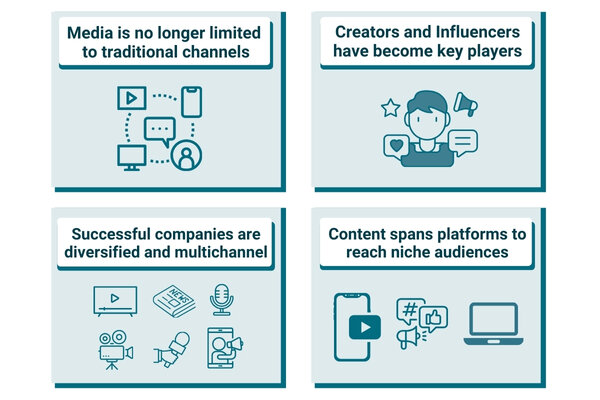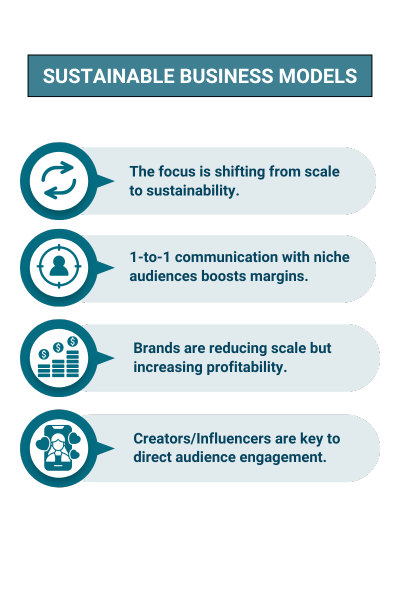Content Driven, Consumer Facing: The Future of the Media Industry
The Media industry has evolved dramatically over the last 10 years. We expect there will be continued consolidation among established companies coupled with the emergence of new players, many with a different definition of content, and the integration of new sources of monetization. We offer a quick overview of some of the trends that have and will continue to influence how the Media & Entertainment sector evolves.

1. The Evolution in the Definition of Media
The traditional focus on a single medium or distribution channel is no longer sufficient to reach an audience or achieve financial success. Successful Media companies are diversified and multichannel and are not limited to established studios, networks, or conglomerates; media today includes Creators/Influencers – some of whom have grown to become substantial media entities in their own right.

2. Sustainable Business Models
The more recent approach of ‘scale at all costs,’ prevalent since the emergence of digital-first media companies, has been replaced by sustainable business models. Of increased focus is the ability of a media company/creator/influencer to speak directly to the audience – changing the model from a 1-to-many to a perception of 1-to-1 communication, which was accelerated by the emergence of Creators/Influencers. Coupled with a 1-to-1 communication approach, many brands/Creators/Influencers focus on identifying and providing content, products, and services to a “niche” audience, resulting in reduced scale but higher margins.
3. The Diversification of Revenue Streams
Some remember 30+ years ago when many media companies had at least the dual revenue streams of subscriptions and advertising. After decades with advertising as the primary source of monetization, successful media companies have returned to the model of multiple revenue streams, bringing back subscriptions as a source of revenue and adding commerce, events, services, and more to the advertising monies.

4. The Proliferation of Video
Video has become the primary medium for content, with the definition of video expanded well beyond long-form theatrical and broadcast/cable television to include short-form stories – frequently from Creators/Influencers - distributed across a myriad of platforms spanning from YouTube (now driving the highest percentage of viewership), social media platforms (Facebook, TikTok, etc.), to Free Ad Supported TV (FAST) & OTT. The consumption of video is across platforms, frequently simultaneously on multiple devices.
5. The Influence of Artificial Intelligence
We have already seen a decline in search as a source of traffic, with AI integrated into existing search engines and new AI platforms being utilized. The disruption of how content is created cannot be overstated and will continue as technology – especially for video creation – advances.
Legal Implications of AI are still unclear as regulators struggle to keep abreast of the changes. Particular concerns relate to fair use, which pairs with the opportunities for some media creators in the licensing of content/data as a revenue stream. For a deeper discussion of our thoughts on the Impact of AI on the Media & Entertainment industry, please reference Media & Entertainment Sector Update | Capstone Partners.
As a result of these trends and other changes – including but not limited to the rise of social platforms, cord-cutting driven by the introduction of OTT/FAST, and the importance of first-party data - we see companies that have not successfully diversified both distribution and monetization facing reduced valuations and potentially becoming unviable. The paradigm of what makes a media company is evolving, those that are unable to evolve are being left behind.
Gretchen Tibbits
Gretchen is a Managing Director at Capstone Partners – IMAP USA, specializing in Media & Entertainment and adjacent verticals. She is based in New York City with active coverage of Los Angeles. Gretchen has more than 25 years of operational experience leading and building media businesses. Her investment banking career includes representing a wide array of clients, such as: TMB (Trusted Media Brands) on its purchase of Jukin Media; Outside (formerly Pocket Outdoor Media) on ten acquisitions, including Outside and OutsideTV; and Wild Sky Media on its sale to Bright Mountain Media.
